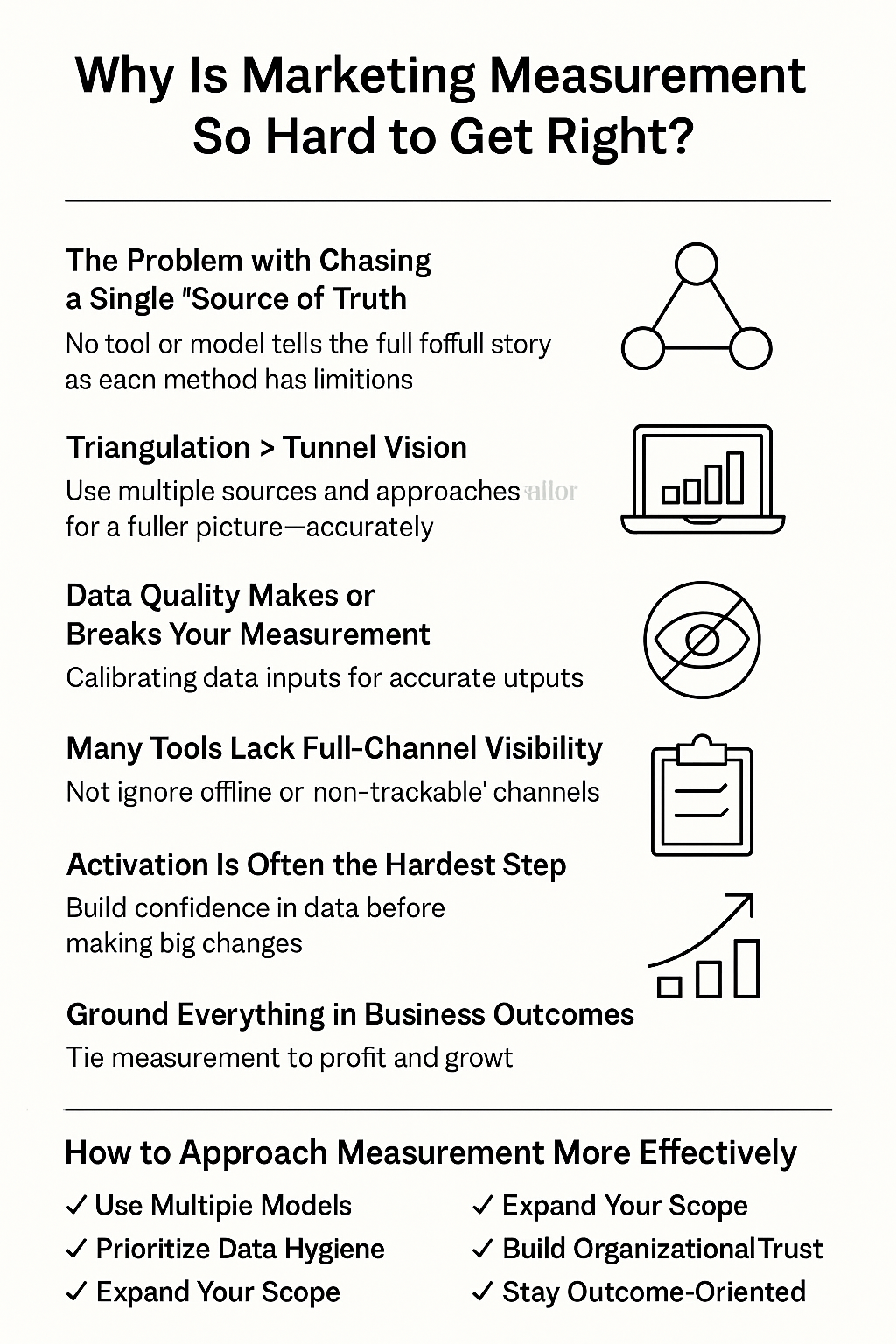Marketing measurement is one of the most talked-about and misunderstood parts of the job. Marketers are under constant pressure to prove ROI, optimize spend, and make decisions rooted in data. But despite the countless tools and models available, most teams still struggle to answer a simple question: What’s really working?
Here’s why: there is no single source of truth in marketing.
Sure, dashboards help. Attribution models offer insight. Media mix modeling (MMM) and incrementality tests shed light on specific levers. But each method has limitations, and when teams treat one as gospel, they miss the bigger picture.
In fact, the only true and complete reflection of marketing’s impact is your profit and loss statement (P&L). Everything else is a model built on assumptions—and those assumptions must be challenged.
Let’s explore why marketing measurement is so difficult, where things go wrong, and what a more realistic and effective approach looks like.

1. The Problem with Chasing a Single “Source of Truth”
Many organizations try to anchor their measurement strategy to a single tool or model, hoping it will provide the clarity they need. But marketing is too complex—and too context-specific—for a one-size-fits-all approach.
- Attribution models (like first-click, last-click, or data-driven) attempt to credit touchpoints but often ignore offline impact or nuances in the buying journey.
- MMM provides macro-level insights over time but lacks granularity and responsiveness to short-term changes.
- Incrementality testing shows what’s working through controlled experiments, but these tests are time-consuming and not always feasible across every channel.
Each of these frameworks is helpful—but partial. Relying solely on one of them often leads to tunnel vision, misattribution, or misleading optimizations.
2. Triangulation > Tunnel Vision
The most effective marketing organizations don’t chase the perfect tool—they combine multiple sources and approaches to triangulate what’s really going on.
Let’s say a brand sees a spike in conversions after launching a new campaign. Last-click attribution says it was search ads. MMM suggests it was TV. An incrementality test finds that removing paid social results in a decline. Which is right?
In this case, all of them might be partially correct. Search ads may have captured the final conversion, but awareness built through TV and social played a vital role. Triangulating these insights helps build a more accurate and actionable picture.
3. Data Quality Makes or Breaks Your Measurement
Measurement doesn’t begin with modeling—it begins with data hygiene.
Marketers often assume that if a platform displays metrics, the data is “good enough.” But that’s rarely the case. Discrepancies across tools, inconsistent tracking, broken UTM structures, or gaps in CRM syncing can all introduce noise and errors.
Common issues include:
- Offline conversions not being tied back to the original marketing source
- Incomplete or missing attribution on third-party partner channels
- Broken pixels or tags that lead to underreporting
- Platform API limitations that exclude certain campaign types
Measurement is only as good as the inputs feeding your models. Without complete, consistent, and calibrated data, even the most sophisticated analytics will give flawed outputs.
4. Many Tools Lack Full-Channel Visibility
Most analytics platforms were built around a limited set of data sources, usually digital. But marketing doesn’t just live in Google Ads and Meta anymore. Brands invest in PR, influencer campaigns, field marketing, sponsorships, affiliates, retail placements, direct mail, and more.
If your measurement system can’t ingest or contextualize these efforts, it’s giving you a skewed view of performance.
Imagine running a massive PR campaign that earns dozens of media placements. You’ll likely see an organic traffic bump, higher branded search, and increased direct visits. But if your reporting tool doesn’t tie that earned media to these downstream effects, you may underinvest in what’s actually driving growth.
Measurement must reflect the reality of your full marketing mix, not just what your tech stack can conveniently track.
5. Activation Is Often the Hardest Step of Marketing Measurement
Even when insights are available, acting on them can be hard. Especially when findings contradict long-held assumptions or suggest major shifts in budget.
Consider this scenario:
- A brand discovers that a paid social channel is underperforming on a CPA basis but contributing heavily to assisted conversions.
- The data suggests pulling back spend and reallocating it to content or influencer programs with a better long-term impact.
Logically, this makes sense. But emotionally—and politically—it can be tough to justify. Decision-makers may resist change, stakeholders may question the validity of the data, and there may be hesitation to pivot from what’s familiar.
This is often referred to as activation anxiety: the fear of making bold changes based on insights that feel unfamiliar or risky.
Overcoming this requires trust—not just in the data, but in the methodology behind it. That’s why layering experimentation (like A/B testing or geo-holdouts) with data modeling can help teams build confidence before making big changes.
6. Ground Everything in Business Outcomes
No matter which models you use, they should ladder up to one central question: Is this driving real business results?
Marketing isn’t about optimizing for the lowest cost per click or the highest CTR. It’s about contributing to pipeline, profit, and growth. That’s why all measurement should ultimately tie back to the P&L.
Here are a few ways to pressure test whether your metrics are aligned with business impact:
- Does this channel or campaign result in high-value leads or long-term customers?
- Are we measuring contribution to revenue, not just media efficiency?
- Can we quantify the impact of this investment on overall margin or growth rate?
If your metrics don’t connect to outcomes your CFO cares about, they probably aren’t telling the full story.
How to Approach Measurement More Effectively
✅ Use Multiple Models
Blend MMM, attribution, and experimentation to get a fuller picture. Each tool is a lens—not the whole map.
✅ Prioritize Data Hygiene
Audit your data sources regularly. Ensure tracking is consistent, complete, and reflective of your actual business activity.
✅ Expand Your Scope
Don’t ignore offline or “non-trackable” channels. Look for creative ways to measure impact indirectly when direct tracking isn’t possible.
✅ Build Organizational Trust
Use small-scale tests to validate insights before making sweeping changes. This helps de-risk decisions and bring stakeholders along.
✅ Stay Outcome-Oriented
Tie everything back to revenue and profitability. Marketing success isn’t about having the most data—it’s about making the right decisions.
Final Thoughts
Marketing measurement will never be perfect. And that’s okay. The goal isn’t perfection—it’s progress. By embracing triangulation, cleaning up data, expanding visibility, and staying focused on business outcomes, marketing teams can move from guessing to knowing.
Forget the dream of a single source of truth. The most effective marketers use multiple tools, ask better questions, and stay grounded in what actually matters: what grows the business.

Hi there! I’m Scott, and I am the principal consultant and thought leader behind Stratus Analytics. I have a Master of Science degree in marketing analytics, and I’ve have been providing freelance digital marketing services for over 20 years. Additionally, I have written several books on marketing which you can find here on Amazon or this website.
DISCLAIMER: Due to my work in the packaging industry, I cannot take on freelance clients within the packaging manufacturing space. I do not want to provide disservice to your vision or my employer. Thank you for understanding.
